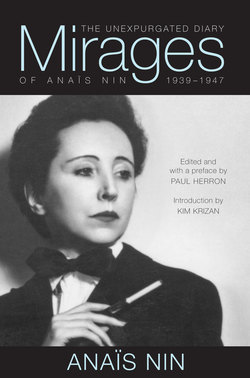Читать книгу Mirages - Anais Nin - Страница 9
На сайте Литреса книга снята с продажи.
ОглавлениеPREFACE
Mirages is the untold story of Anaïs Nin’s personal struggle to keep alive what she valued most in life—the dream—in the face of the harsh, puritanical climate of 1940s New York. It is a record of a journey across what Nin called the “desert before me” and witness to her painful rebirth as a woman and writer. It is the story missing from The Diary of Anaïs Nin, particularly volumes 3 and 4, which also cover 1939 through 1947.
This book finally answers what readers have been asking for decades: What led to the demise of Nin’s love affair with Henry Miller? Just how troubled was her marriage to Hugh Guiler? What is the story behind Nin’s “children,” the effeminate young men she seemed to collect at will? How was it that Nin wrote so prolifically during such a tumultuous time? What is the truth about her mysterious relationship with Gore Vidal? And what was it about Rupert Pole that seemed to assuage all the pain Nin had endured?
In 1939, shortly after fleeing wartime Paris for New York, Nin wrote: “Over and over again I sail towards joy, which is never in the room with me, but always near me, across the way, like those rooms full of gayety one sees from the street, or the gayety in the street one sees from a window. Will I ever reach joy?” By 1946, her search had devolved into agony: “The greatest suffering does not come from living in mirages, but from awakening. There is no greater pain than awakening from a dream, the deep crying over the dying selves…”
As World War II spread across the world, Nin waged her own war against a reality she found so horrifying that she repeatedly contemplated suicide and sought temporary salvation in numerous doomed love affairs with an assortment of men, ranging from the staid critic Edmund Wilson to seventeen-year-old Bill Pinckard, searching for the “One” who could respond to her, not only sensually, but completely. When none of her many lovers could live up to her ideal, she exclaimed to the diary: “Oh, someone, someone love me as I have loved.” It was only after abandoning her quixotic quest that Nin met Rupert Pole, the ardent lover who seemed to answer her needs—and who would eventually prompt her to swing back and forth across the continent between him and her husband for the rest of her life.
Nin wrote in 1943, “I feel like rewriting the entire diary in two columns: the actual diary as it is and its completion à la Proust—filling, rounding, objectifying, encircling, encompassing all.”
While Nin never actually put her diary into two columns, this aspiration was achieved, to an extent, in her publication history. She published the “objectified” version in the form of The Diary of Anaïs Nin, but with one major omission: because her husband and some of her lovers were still alive at the time, she was forced to excise an entire side of her character—the erotic—from the text. While Mirages could have been a simple accumulation of what was left out of the Diaries, the higher aim was to assemble the most meaningful material from the missing “column” and reconstruct Nin’s story, and what a story it is.
Here, the hazy, almost imagined images and the vague angst of the Diary snap into eye-searing focus, cast in a strong, sharp, defining light, laid bare for the reader. It is sometimes shocking, sometimes beautiful, sometimes agonizing, with little left to the imagination. The personages of the Diary become real people with real flaws and real problems; the transformation Nin undergoes is made brutally clear.
Mirages is a document of heartbreak, despair, desperation, carnage and deep mourning, but it is also one of courage, persistence, evolution and redemption.
PAUL HERRON, EDITOR
San Antonio, Texas March 2013
